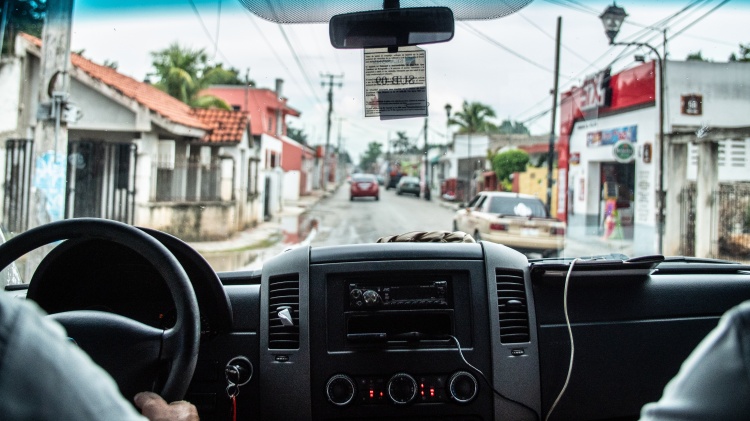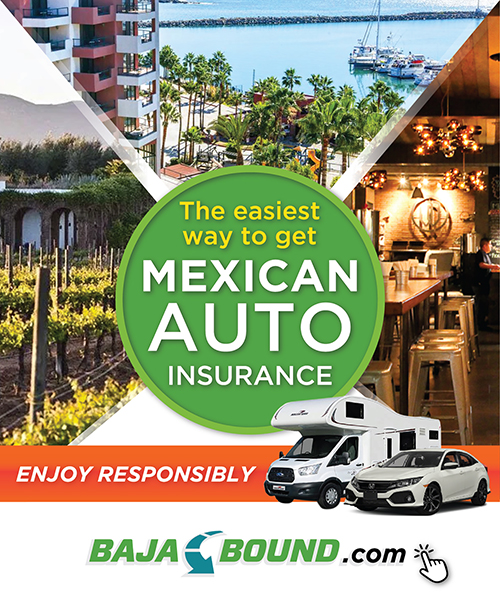Driving in Baja
Driving in Baja can be one of the most rewarding means of travel. It can also be if one is not careful and alert, somewhat dangerous. It is very difficult to get lost once you are out of the border area, as there are only five main (nationally numbered) highways along the entire length of the peninsula.
The main highway, México 1, runs the whole length of the peninsula, from Tijuana to Cabo San Lucas. This 1,058-mile highway is mostly well-paved but is in a constant state of repair. While this is the most highly-traveled tourist route, it is also the main route for the large trucks that bring most of the supplies from the border area to the southern regions of Baja.
México 2 (and 2D, a toll road out of Tijuana that connects with Highway 2 near Tecate) runs from Tijuana to the East through Tecate and on to Mexicali. It then continues across the Sonoran Desert and ends up connecting with México 15, north of Hermosillo, on the Mexican mainland.
México 3 runs south from Tecate through the hilly northern wine country and connects with Highway 1 just north of Ensenada. The second part of Highway 3 goes across the mountains (out of Ensenada) to the east through Ojos Negros and Valle Trinidad to finally connect with México 5, on the Sea of Cortez, approximately thirty miles north of San Felipe.
México 11, is actually an extension of the main seaside boulevard (Malecón) in La Paz and continues to the north, out of La Paz, ending at the ferry terminal (ferries to Mazatlan and Topolobampo on the Mexican mainland) at Pichilingue. This highway (really just a road) travels along the Bay of La Paz and passes by some very beautiful beaches and coves.
México 19 is in the far south of the peninsula, branches off Highway 1, 16 miles south of La Paz, and provides a shortcut to Los Cabos, through the charming town of Todos Santos. Stay on México 1 to get to the beaches and resorts of the East Cape area and San Jose del Cabo.
You will need to obtain a tourist permit (FMM) if you are planning on driving south of Ensenada or San Felipe on the eastern coast.
Although driving in Baja can be very rewarding, and mostly trouble-free, it comes with a few warnings that need to be heeded, and also a few surprises. The first and most important warning is that night driving is to be avoided by almost everyone. The second (and equally as important) – get a Mexican Car Insurance policy before you cross the border! Third (and equally important, again) drive at a reasonable speed. Pretty easy rules for a safe trip, if you follow them you should be OK.
You may find cows (and other animals) on the road as well as slow-moving vehicles (sometimes with no lights). The road is pretty narrow and has a little-to-no shoulder in most places. These are the factors that make night driving a big No-No, especially if you have not made this drive numerous times. This means that you should carefully plan your trip to make sure that you arrive at your planned destination of the day, before nightfall.
Some other surprises can be the lack of gas (less of a problem these days), slow trucks in the mountainous areas, flooded sections of the road (usually in the summer), or long waits for construction crews to finish a section of work. The road has a tendency to be very twisty in places. Somewhat lengthy (not always) random vehicle checks by the army or federal police, designed to prevent the flow of arms and drugs, can also make for a longer (time-wise) drive than you had originally planned.
Watch out for topes while driving in Baja! Topes are speed bumps that may or may not have been placed by the proper authorities. Some cities, even individuals, will place them on the road illegally, to control the speed of vehicles in their area. If you hit them at speed, it can be bad and may even damage your car. Most (legal topes) are marked with signs or are painted yellow or white.
Don’t let any of this discourage you from driving in Baja. The scenery can be absolutely incredible and the locals are some of the most friendly people on the face of the earth. There are endless stories of the locals appearing out of nowhere to repair cars, help with tire changes, and provide gas, oil, or other needed items.
Also, on the positive side, is the fact that all main highways are patrolled by the Green Angels, a branch of the tourism department that was created especially to help travelers with vehicle problems. They carry gas, oil, tools, and other necessities and provide service to anyone who needs help along the highway. The Green Angels only patrol during the daylight hours.
If you choose to drive, you will be treated to some of the most spectacular scenery you could ever imagine.
City driving in Baja must be monitored very closely. In most cities in Baja, you should drive with a lot of extra caution. Drivers in Baja tend to have a common disregard for the traffic laws (yes, they really do have traffic laws) and many drivers lack common road courtesy. Stop signs are often ignored, in some places, they actually speed up for stop signs. You should learn to expect turns (in either direction) from any lane on the road. Also, many streets and roads may lack basic markings, even one-way streets.
Driving in Baja can be a real adventure. The fine line that separates an adventure from a disaster can be just one bad decision or a small lapse in attention to the road. You hardly ever see any minor accidents in Baja, most accidents tend to be major. Just look at the number of shrines along the road, reminders of the need to pay attention while driving. Highway 1 is, in most places, pretty narrow by anyone’s standards. Along most of the road, the lack of any shoulder can make for some nervous times.
Be extra careful while passing another vehicle. Be aware of everything around you, look way ahead, and keep an eye on your rear-view mirrors. When I approach a vehicle, from behind, to pass, I always check to see if they actually have a mirror glass in their mirror. Then, I know that they will be able to see that I would like to pass. I also, watch carefully to make sure that they have actually seen me before I make the pass. Sometimes, a polite blink of the headlights is in order to make sure they know you are there.
Use extra care in the mountains and on all curves. Large trucks tend to use both sides of the road at times. The truckers driving in Baja are usually great drivers and very considerate of oncoming traffic and those who want to pass them. There are exceptions to the rule and there are occasions when the good ones will slip up, as can happen anywhere.
You will undoubtedly notice that a large number of cars and trucks on the road are not in the best state of repair. This can sometimes make for erratic driving and other difficulties for the driver. Give older cars, and trucks, a little more room than you normally would. Note: Before any trip to Baja, make sure that your vehicle is in a good state of repair.
If you feel that you are getting tired, pull over, splash some water on your face, go for a walk, have a short nap, and do whatever works for you. It doesn’t matter how hot it is or how late you will be, it is better to arrive late – than to not arrive at all.
That said, I do not want to scare you away from driving in Baja. I just want you to know that this is not a drive to your corner market. The incredible scenery, friendly people, and unique experiences will more than make up for the extra care you must use during your time behind the wheel in Baja.



